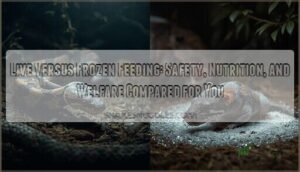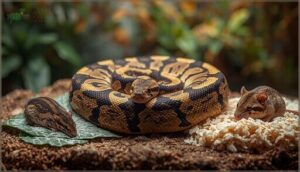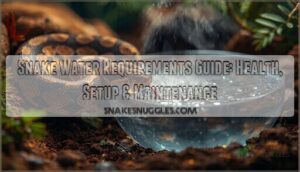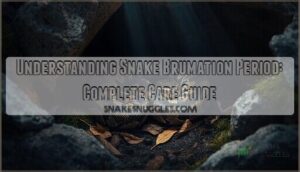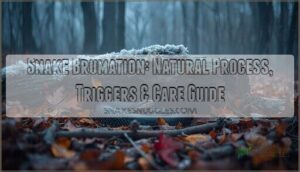This site is supported by our readers. We may earn a commission, at no cost to you, if you purchase through links.
A careless rodent can leave more than bite marks—a single confrontation with live prey can leave your snake nursing wounds for weeks. Yet, watching a healthy python stalk and strike, all muscle and instinct, feels close to what nature intended.
Live versus frozen feeding isn’t just about convenience or tradition; it’s a balancing act between your snake’s well-being, nutritional needs, and your own peace of mind. Every feeding decision shapes safety, nutrition, and ethics—and the details are often more complex than they first appear.
Table Of Contents
Key Takeaways
- Feeding frozen prey nearly eliminates injury and disease risks for your snake, making it safer than live prey.
- Nutritional value is similar between live and frozen prey, but frozen food can lose some vitamins over time.
- Choosing frozen feeders supports better animal welfare by reducing prey suffering and aligning with humane practices.
- Frozen prey is more convenient, cost-effective, and easier to handle than managing live rodents at home.
Safety and Health Risks of Feeding Methods
How you feed your snake can affect its health, safety, and peace of mind. Different methods come with their own set of risks and precautions.
Let’s look at what matters most when choosing how to feed in your setup.
Injury Risks From Live Prey
When you feed live prey, the rodent’s bite can pack a real punch. Rodent Bite Trauma often leads to open wounds, severe facial or spinal injuries, and sometimes permanent damage. Infection Complications and deep abscesses frequently follow, especially if wounds go untreated.
Comparative Safety data consistently shows that frozen-thawed prey nearly eliminates these injury risks for your snake. Ball pythons, a common species, are also susceptible to metabolic bone disease.
Disease Transmission Concerns
Besides wounds, you also face disease transmission concerns each time you use live prey. Zoonotic pathogens—think bacteria, parasites, and viruses—thrive with live rodents and insects. Salmonella risks are especially real, even with frozen prey. Freezing dulls some parasite threats but can’t erase all dangers.
- Bacteria persist on fur and skin
- Parasite freezing isn’t always effective
- Insect vectors introduce zoonotic diseases
- Reputable frozen suppliers reduce risk of disease
Switching to frozen options can greatly reduce the risk of injury and disease.
Safe Handling Practices
Even frozen prey isn’t risk-free without proper hygiene. Always wash your hands and use gloves after any contact with reptiles or feeder items—don’t forget bacteria and zoonotic diseases hide where you least expect.
Disinfect tongs and surfaces, store prey separately, and avoid food prep areas. Protective equipment shields vulnerable populations, making your feeding routine both safe and dependable.
Nutritional Value: Live Vs Frozen Prey
Regarding nutrition, both live and frozen prey offer essential building blocks for your snake’s health. But there are some key differences you’ll want to keep in mind. Here’s what matters as you weigh your options.
Protein, Fat, and Vitamin Content
Imagine picking the best fuel for your snake—protein comparison shows live and frozen rodents both offer substantial proteins and stable fats, making Snake Nutrition steady either way. Vitamins ride along in gut content, but retention shifts with storage. To meet your snake’s nutritional needs, consider this simple breakdown:
| Component | Live & Frozen Prey |
|---|---|
| Proteins | Similar |
| Fats | Stable |
| Vitamins | Gut-dependent |
| Supplement Needs | Occasional |
| Nutritional Needs | Satisfied |
Nutrient Losses in Frozen Prey
When you rely on frozen feeding, some essential nutrients—especially vitamins—can slip away over time. Vitamin degradation, thiaminase effects, and lipid oxidation all chip at nutritional value, particularly with longer storage duration. Yet, mineral stability and protein remain steady. Here’s a quick look:
| Nutrient Change | Frozen Prey Impact |
|---|---|
| Vitamin degradation | Moderate to significant |
| Mineral stability | Largely preserved |
| Lipid oxidation | Increases with time |
| Thiaminase effects | Reduces vitamin B1 |
Prey Gutload and Supplementation
For best animal nutrition, focusing on gut-load timing makes a tangible difference. By boosting feeder insects with foods high in calcium ratios and vitamin enrichment 24–48 hours before feeding, you help essential nutrients and D3 supplementation reach your snake. Still, too much or too frequent supplementation raises excess risks.
| Approach | Benefit | Possible Risks |
|---|---|---|
| Gut-loading | Enhances vitamins | Over-supplementation |
| D3 Dusting | Boosts minerals | Soft tissue mineralization |
| Balanced schedule | Maintains health | Deficiency or toxicity |
Animal Welfare and Ethical Considerations
Regarding what you feed your snake, their well-being and how you handle ethical choices go hand in hand. The approach you choose affects both your pet and the animals used for food.
Let’s look closer at some key considerations you’ll want to weigh before making your decision.
Prey Suffering and Humane Practices
Would you let your dinner scream for mercy? Animal welfare begins with empathy for even the tiniest creatures. Euthanasia methods like carbon dioxide minimize prey suffering, meeting both regulatory guidelines and animal ethics and welfare standards.
Empathy for all creatures demands humane feeding—methods like carbon dioxide euthanasia minimize suffering and uphold animal welfare
Public attitudes now lean toward humane treatment, with welfare outcomes consistently showing frozen prey as the ethical, responsible choice to address prey distress and ethical considerations head-on.
Snake Stress and Well-being
Stress can undercut your snake’s health faster than you think. Safe Feeding Stressors come from more than just food choice—Handling Impact, lack of Environmental Security, and sudden changes all matter. Here’s how you monitor and support Mental Health through Animal Welfare:
- Minimize stressful handling
- Provide hiding spaces
- Feed in low-disturbance areas
- Read Behavioral Indicators
- Prioritize Stress Reduction
Responsible Feeding Choices
Ethical considerations in snake feeding aren’t just theory—they shape every choice you make. Owner responsibility means putting snake health first while respecting prey welfare.
Feeding guidelines now favor frozen prey, as it balances animal welfare and ethics with practicality. Live prey is only justified when absolutely necessary, after every method to switch to frozen options has been exhausted.
Practicality and Cost of Feeding Options
When you weigh feeding options for your snake, practical concerns matter just as much as nutrition. Costs, time commitment, and upkeep can quickly shift the balance. Here’s what you’ll want to think about before you choose.
Cost Comparison and Bulk Buying
Let’s talk numbers: bulk buying frozen rodents nearly always wins for cost-effectiveness and convenience. Live husbandry adds indirect costs—feed, upkeep, even medical bills from bites.
The bigger your collection, the more bulk pricing or regional variation in shipping matters.
Compared to rodent breeding at home, bulk orders cut hassle and keep your costs in check, especially long term.
Storage, Maintenance, and Time Commitment
Frozen prey wins for pure convenience—freezer shelf-life stretches months, provided you follow proper packaging needs and food handling. Stack your rodents, label bags, and keep them isolated from household groceries.
In contrast, live-feeder upkeep means daily tasks and cleaning routines. The time commitment and space considerations for live prey can quickly turn what’s manageable into a full-time chore.
Breeding Your Own Rodents
If keeping frozen feeders is simple, raising your own breeding rodents adds layers of responsibility. You’ll need to manage breeding space needs, set colony size limits, and maintain strict disease risk mitigation.
Consider:
- Rodent diet and regular feeding cost analysis
- Extra labor time input for cleaning and care
- Systematic rodent breeding setup
- Detailed breeder records and weaning schedules
Efficiency and welfare hinge on daily diligence.
Behavioral and Enrichment Aspects
If you want your snake to thrive, providing the right feeding experience is just as important as nutrition. The way you offer food shapes natural behaviors and keeps things interesting.
Let’s look at some options that can make feeding time safe and engaging.
Stimulating Natural Hunting Behaviors
Inviting your snake to hunt as it would in the wild sparks instinct and strengthens both body and mind. Encouraging natural hunting behaviors—through moving prey or creative enrichment—boosts strike accuracy, foraging efficiency, and muscle engagement.
Each feeding offers mental stimulation, enhances cognitive engagement, and aids stress reduction, keeping your snake alert, resilient, and naturally fulfilled by the chase.
Transitioning Snakes to Frozen Prey
After sparking your snake’s natural instincts with hunting games, you might notice some feeding difficulties when offering frozen prey, especially to finicky eaters. Owner consistency matters here. You’ll want to watch for:
- Shift success rates by age
- Husbandry impact on appetite stimulation
- Patient use of proven shift techniques
- Tackling common challenges
- Monitoring for ongoing feeding difficulties
Feeding Techniques for Success
When you approach snake feeding, success relies on more than just snake feeding methods—it’s about using tongs and handling each meal with purpose. Temperature matters; thaw prey fully, then warm to body heat. Mimic movement to awaken hunting instincts.
Keep a steady feeding schedule, practice smart hygiene, and always apply proper prey handling guidelines for both frozen feeding and live feeding.
Frequently Asked Questions (FAQs)
Can feeding methods affect snake longevity or lifespan?
Lifespan determinants in snakes hinge on many variables, but feeding impact plays a large role. Poor prey quality or repeated health risks—including injuries from live prey—can reduce longevity, while proper nutrition and safe practices encourage long-term positive health outcomes.
Are there differences in waste or odor production?
Controlling odor and managing waste come down to what you feed. Live prey leaves more uneaten remains, bumping up enclosure cleaning frequency and microbial load.
Frozen options simplify odor control methods and offer environmental waste reduction, boosting both health and ease.
What are signs of digestive issues after feeding?
Pay close attention after feeding—regurgitation signs, anorexia causes (like skipping meals), stool changes, and impaction risks all flag digestive issues.
Lethargy signs and abnormal behavior may reveal deeper reptile health or animal health concerns needing quick action.
How can you tell if a snake is still hungry?
When hunger comes knocking, your snake’s activity patterns pick up—think restless prowling, rapid tongue flicks, or tracking movement at feeding time.
Notice pronounced spine visibility in body condition, and persistent feeding response even after routine snake feeding cycles.
Conclusion
When you weigh the risks and rewards, which matters more: your snake’s instinct or its safety? The choice between live versus frozen feeding travels beyond habit, reaching into the heart of responsible care.
Every meal is a decision, a reflection of your understanding and compassion. By questioning your methods, you honor the animal’s nature and your role as its keeper.
The right feeding path isn’t just practical—it’s the one you can justify, every single time.
- https://covenantwildlife.com/blog/the-consequences-of-using-live-rodents-as-reptile-food
- http://blogs.thatpetplace.com/thatreptileblog/2014/07/11/thawing-frozen-mice-and-rats-for-snakes-and-other-reptiles/
- https://www.visionproducts.us/blog/frozen-vs-live-rodents-what-should-i-feed-my-snake/
- https://petfoodpassion.co.uk/2025/02/11/the-nutritional-value-of-common-live-frozen-reptile-foods/
- https://europezoos.com/zoopedia-the-a-to-z-encyclopedia-for-zoos/animal-feeding-in-european-zoos/

